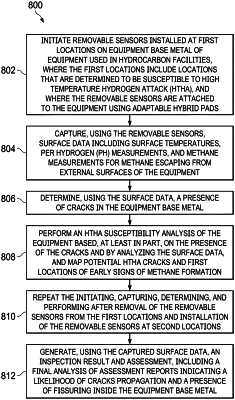| CPC G01N 27/9006 (2013.01) [G01N 27/904 (2013.01); G01N 27/9073 (2013.01)] | 20 Claims |

|
1. A computer-implemented method, comprising:
installing, using at least one drone configured with an extended arm, removable sensors at first locations on base metal of equipment used in hydrocarbon facilities, wherein the first locations comprise locations that are identified as being susceptible to formation of microcracks due to high temperature hydrogen attack (HTHA) based on a history of the equipment, and wherein the removable sensors are attached to the equipment at elevated heights on the equipment using adaptable hybrid pads, the removable sensors detecting the microcracks by adhesion force based on a high-temperature suction substrate adhering up to a set temperature during an inspection processes;
capturing, using the removable sensors and as captured surface data, surface data comprising surface temperatures, per hydrogen (pH) measurements, and methane measurements for methane escaping from external surfaces of the equipment;
determining, using the captured surface data, a presence of the microcracks in the base metal;
performing an HTHA susceptibility analysis of the equipment based, at least in part, on the presence of the microcracks and by analyzing the captured surface data;
mapping, based at least on the HTHA susceptibility analysis, potential HTHA microcracks and first methane formation locations presenting early signs of methane formation;
installing, using the at least one drone configured with the extended arm, the removable sensors at second locations on the base metal of equipment used in hydrocarbon facilities, wherein the second locations comprise locations that are identified as being susceptible to formation of the microcracks due to the HTHA based on a history of the equipment;
capturing, using the removable sensors and as the captured surface data, the surface data comprising the pH measurements, and the methane measurements for the methane escaping from external surfaces of the equipment;
determining, using the captured surface data, the presence of the microcracks in the base metal;
performing microcracks HTHA susceptibility analysis of the equipment based, at least in part, on the presence of the microcracks and by analyzing the captured surface data;
mapping, based at least on the HTHA susceptibility analysis, potential HTHA microcracks and second methane formation locations; and
generating, using the captured surface data, an inspection result and a suggestion, the inspection result comprising a final analysis of assessment reports indicating a likelihood of microcracks propagation and a presence of fissuring inside the base metal and the suggestion comprising a modification of an operation of the equipment to prevent risks indicated by the inspection result.
|